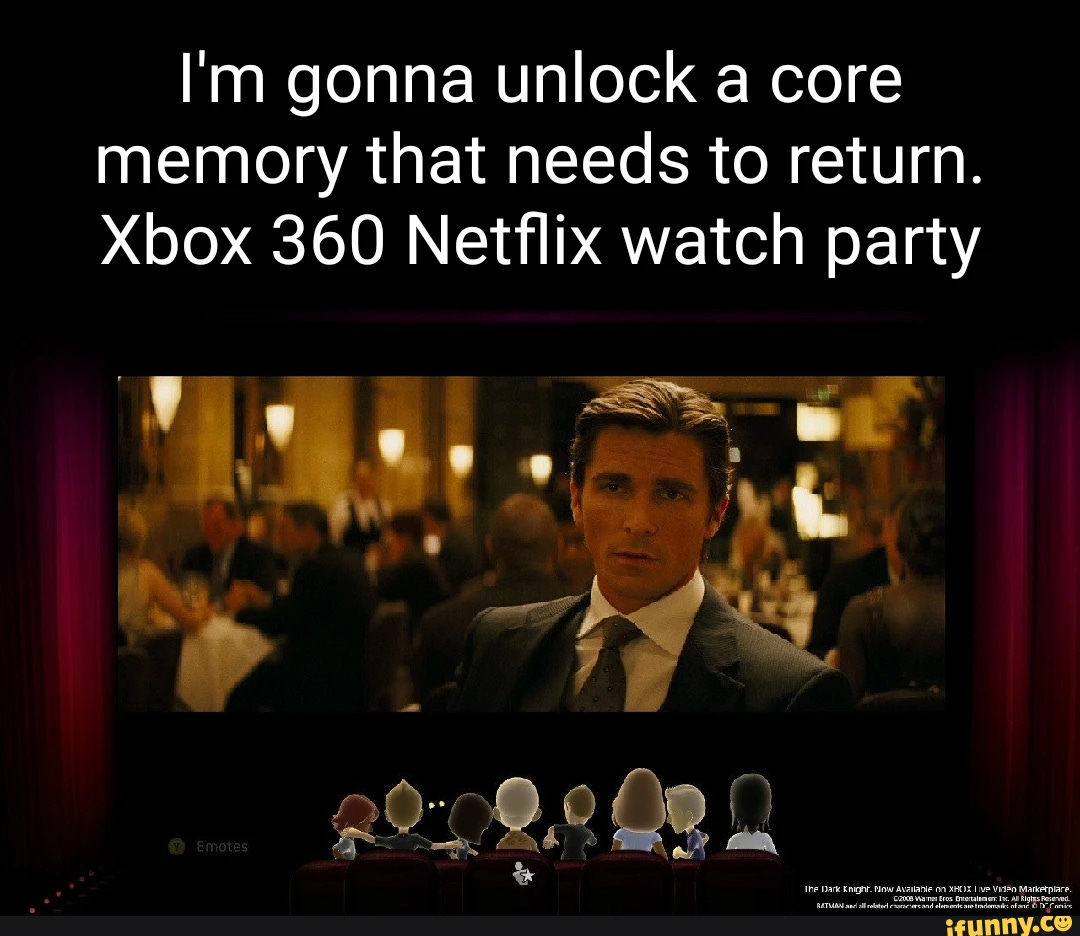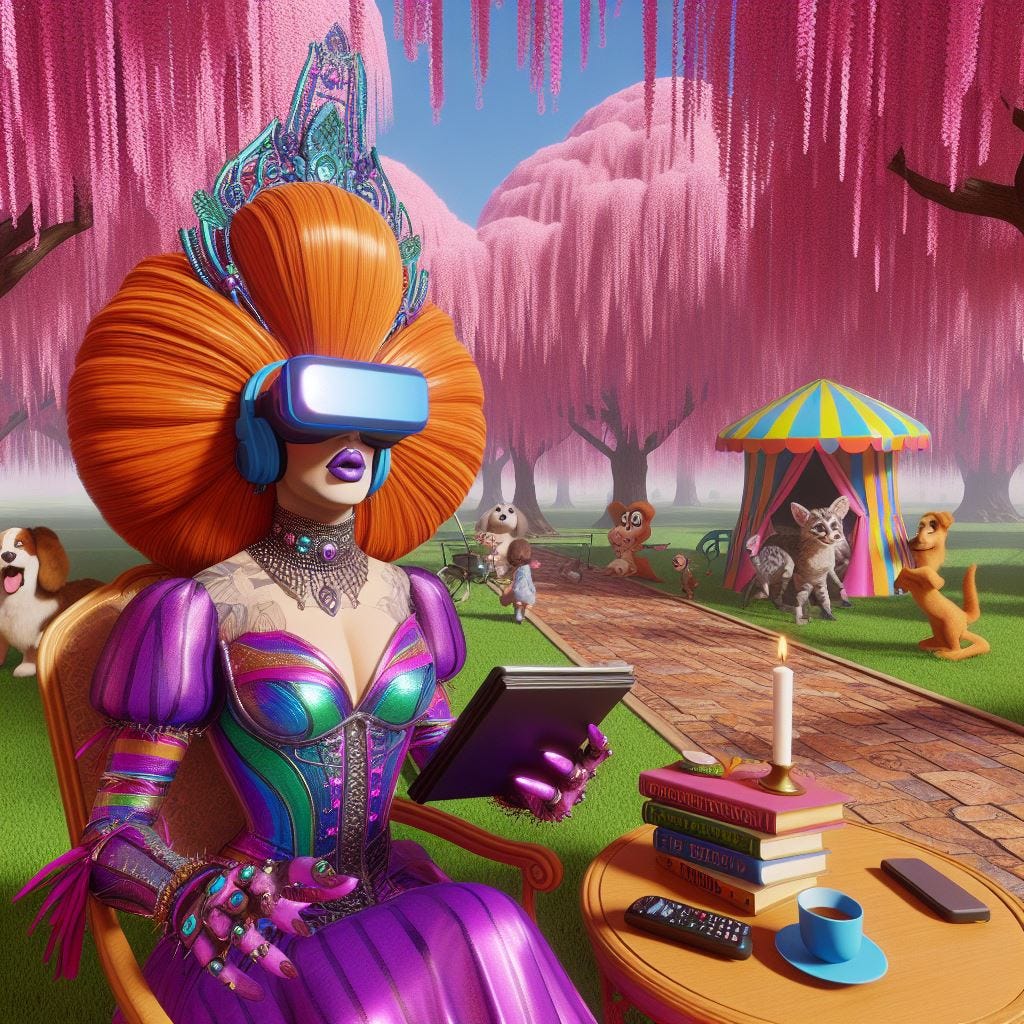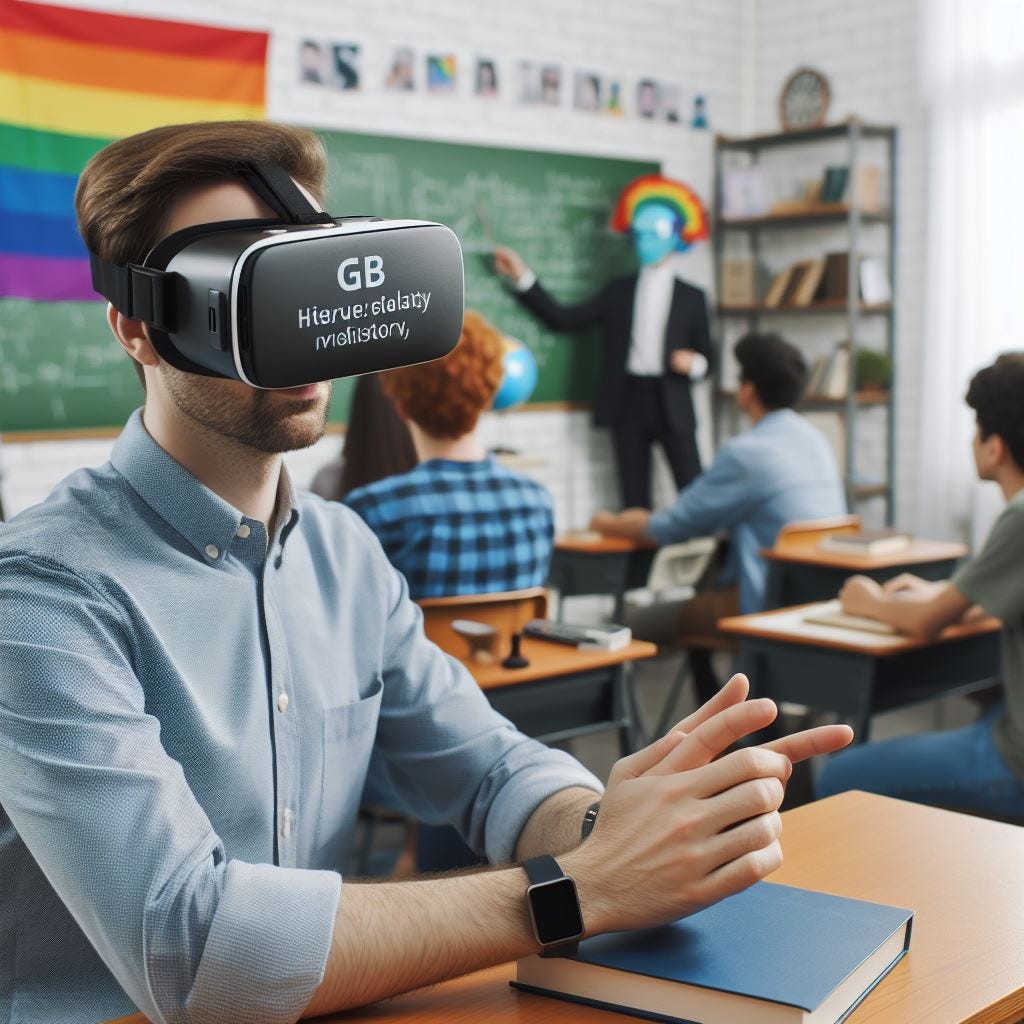Computing Queer Spaces Part 1: A People Full of Possibility
Spatial Computing is coming. What do we, Queers, do about that?
Welcome back, everyone. It’s been a while. We’re pivoting away from comics criticism for now and focusing on technology and Queerness. The internet has been a profound tool for connecting Queer people, especially when we can’t connect in-person. I was an AOL Chat Room girly, a BGC girly, and a Craigslist girly. IYKYK. The internet was a pathway to other Queer people before and after I came out. Unsurprisingly, I think about Queerness and digital ecosystems a lot, even passively. I think about how many of us learned about sex through porn or streamed Queer as Folk and Noah’s Arc on semi-legal sites or learned what “painting” was through online chatter. The internet has been our way to get around the surveillance of and the barriers constructed by cishet people. Our Gateways to a digital Krakoa.
I’ve been consuming a lot of information about artificial intelligence and other technologies on the frontier (the Fediverse, dApps, etc). I have found Leo Herrera’s writing on Generative AI and gay porn informative, visually stimulating, and instructive as we carve out our collective and individual ethics around Generative AI. I’m also very proud to say that he agreed to answer some questions for this very piece and I want to thank him again for his support. Please do yourself a favor and subscribe to his Substack. His piece “The Rape of Henry Cavil” was critical to my thinking around the dangers and potential of “AI art.” As an avid porn consumer, I regular think about the distribution of revenge porn, rape-y content (I don’t mean clear dom-sub play), and our eroticizing of the violent and profane. Twitter Porn has escalated that problem to new levels. Before the disgusting Taylor Swift images, Henry Cavil images were flooding the gay web, and it was bad. Herrera helped me unpack what that said about our culture, rape culture, and emerging technologies. Sadly, I have yet to see anyone else digesting Queerness and AI, but, today, I’d like to do that for another emerging technology: Spatial Computing/Mixed-Reality.
What are spatial-computing and mixed reality? The laziest explanation is that it’s what the Apple and Meta are working on right now with the Vision Pro and Oculus. It’s the mixing of virtual reality and real life, currently through headsets. I’ve started a glossary, but here’s a quick breakdown of terms.
The one and only Matt Stoller, Research Director at American Economic Liberties Project, recently wrote a piece called “It’s Apple’s Vision Pro, The Rest of Us Just Live Here” about the firm’s new product. This piece is required reading for my post. He outlines the current landscape for spatial-computing technology including the emerging duopoly in software by Meta and Apple. Note that this duopoly mirrors the duopolies in smartphone markets with Apple’s App Store and Google’s Play Store dominating the mobile app markets and Apple’s iOS and Google’s Android as the primary operating systems for smartphones. Like the hardware market for smartphones, there seems to be a fairly diverse and dynamic market for VR headsets which is good. The problem will be operating systems, applications, and integration with our existing world. Apple is currently being sued by the Department of Justice Antitrust Division for its monopolistic practices, specifically its “walled garden” tactics around iPhones and other products like the Apple Watch. Meta is being sued by the Federal Trade Commission for its purchases of Instagram and Whatsapp as well. Facebook isn’t a walled garden like Apple’s ecosystem yet because they don’t have many physical products. In fact, the purchase of Oculus now looks more like an attempt by a floundering monopolist to acquire hardware products because it couldn’t develop any on its own. No shade. Mark Zuckerberg’s vision for the “Metaverse” (mixed-reality) always felt walled and garden-y.
It feels like taking Meta’s addictive products and combining them with immersive hardware, so they can plug us into the Marktrix, sell our data, and use that data to create more addictive bullshit. I’m not being hyperbolic; that is what I think they want, and it should terrify everyone. At the same time, if you read Stoller’s piece and watch Cleo Abram’s Youtube video on the Apple Vision Pro, it’s clear that there is a positive future for spatial computing out there. Without ignoring any of the market and health concerns, I am genuinely optimistic about the possibilities of spatial computing technology. When I finished Matt’s piece, I couldn’t help but think of all of the amazing things Queer people could do with this technology; I was excited and joyous. There is a Queer future within extended-reality that can be achieved by centering community-formation, education, online safety, and self-determination for Queer people.
Freaks on the Frontier
Marginalized people, Queer people specifically, are often on the forefront of technology, especially in the Digital Age. When you live on the margins and in a scattered population, communication technology and connection are paramount. The margins are generative places because there are needs or desires there that normative and centered people have the privilege of not considering. My understanding is that cam boys and girls are the reason we have streaming today by developing the software and modeling the economics of subscription and pay-per-view streaming. Drag Queens and Queer makeup artists drove the makeup boom of the 2010s and are the reason you can go find your exact shade at Sephora. As awful as he is, Jeffree Star was integral to the explosion in beauty brands and, eventually, more inclusive palettes. Queer people, and friends, are constantly pushing the boundaries of what is possible long before our cishet counterparts could even conceive of a smooth contour. What does that have to do with the Apple Vision Pro? Well, in her video on the the product, Cleo Abram says that, “Digital teleportation is a possible future here, and that is the future I wanna shoot for.” We have the potential to bring our Queerness to each other in ways that are radically more innovative and connective than a Zoom drag show or book club.
Possibilities in Performance
While mixed-reality streaming isn’t quite there yet, videos are. Streaming and watching pre-recorded performances have the potential to connect Queer people nationally and globally. In the arts space, we could be streaming drag performances in our living room. Imagine being able to stream the finale of Rupaul’s Drag Race in your living room, maybe even in a chat room with friends like the old Xbox Live watch parties.

For Queer designers, they could expand the audience of their fashion shows both by democratizing them to us lay people and creating access points to industry movers and shakers who can’t or don’t want to go to El Paso or Chattanooga. That designer making suits for Trans Men wouldn’t need to go to New York or LA; they could put on a show from a gallery space in Little Rock and stream that to your living room or a fashion journalist’s office.
In the sexual realm, we have the opportunity to better protect sex workers and bring sexual performance to more people. I see clips on Twitter of sex shows at gay parties/clubs in Europe and long for those sorts of shenanigans. Club Lambda in Brooklyn (NSFW) has a recurring party with sexual performance called Meatfest. What if we could bring Meatfest to you? What if you could be there in the club in London with all the sites and sounds while John Thomas (NSFW) gets fucked and fisted on stage? Frankly, I don’t even care if that interests you because it interests me and enough people to attend the parties and retweet the clips. For our less piggy friends, consider long-distance intimacy with a partner or partners. People have been doing phone sex, Skype sex, and Facetime Fun Times for as long as each of those technologies have existed. Let’s go further. My friend lives in NYC and his husband lives in Saudi Arabia. Mixed-reality offers them a lot of potential for sexual or simply romantic connection. I know wearing a VR headset is clunky right now, but, as the technology becomes more compact, I can imagine date nights between couples where their avatars are right with them. I can also imagine quite a fun cucking scene with one partner across the globe with an Apple Vision Pro and their partner with a camera and however many sexual partners they need for a good time. I’ve also seen quite a few porngraphic videos that combine hypnosis or machinery and sex toys (NSFW). Scaling those things up with immersive technology seems like a recipe for a good time. I don’t recall the exact video but I believe I’ve seen some kinky folks already experimenting with these ideas. How fun would an immersive Poppers Trainer be? It might seem silly or embarrassing to think of how raunchy these futures could be, but that’s the generative space where people on the margins merge desire and technology.


Working Gworls
When thinking about democratizing and decentralizing performance and sex work, I’m always concerned about the gurls getting paid. While piracy of immersive content will likely happen, Leo Herrera notes that “We already see [innovative sex work] on Fan sites in the form of private, intimate chats and custom videos tailored to specific clients.” The threat of unpaid work already exists but with mixed-reality, we open the possibility for performers, like drag performers, to create immersive experiences while also being able to gatekeep through ticketing, tips, and subscriptions. I return to the Cam Boys of it all. They get tipped on their sites. Pay-per-view already exists so bringing that to a live drag show or the Drag Race Finale is not impossible. I’d much rather be able to pop into a live drag show in Chicago and tip the queens than see their performance on Youtube where they enjoy little to none of the financial benefits. I also believe that creating opportunities for sex workers to decide their level of proximity to clients is paramount. I presume that many sex workers would rather send a personalized video or do an immersive strip show than meet someone at a hotel, if the pay is equal or better.
Community without Borders
There are also possibilities beyond the sexual. The internet has been a means by which Queer people can form community, and I see so much opportunity to do that with spatial computing technology. Take a book club. Doing a Zoom book club is cute, but what if you can put everyone in your living room or by the Eiffel Tower? As the motion capture technology evolves and the headsets become more compact, your avatars will better convey your expressions. Laws relegating Drag Performance, specifically Drag Queen Story Hour, have swept conservative states in the US. Mixed-reality applications could allow families and performers to circumvent zoning and public space laws that constrict these sorts of events. In a brighter future, local libraries would have live audiences for Drag Queen Story Hour and be able to create immersive livestreams for children and families across the country. The immersive component allows for more engagement than Zoom and more participants than Facetime. I’m sure parents that homeschool children are already considering these technologies and I think we should as well.
Just as Queer children, Queer parents, and friends deserve the communitarian potential of spatial computing, they may also have profound impacts on Queer adults. Mutual-aid groups for a variety of members of our community are quite common. Forums and groups for People Living with HIV/AIDS, for sober community members or members dealing with addiction, for Trans and Non-Binary folks, for Queer parents, and Parents of LGBTQIA youth are staples in our community. Many of these groups moved to Zoom during quarantine, but the ability to create more intimate spaces would go so much farther. I understand that wearing an Oculus while talking about your new HIV diagnosis doesn’t seem glamorous but I think a virtual setting of the group’s choice is much better than staring at a laptop. Much like Drag Queen Story Hour, there’s potential for these mutual-aid groups to expand the reach of their services beyond physical spaces and be more inclusive of People with Disabilities or those located outside of major metros with Queer communities. Maybe that person can’t travel from Spotsylvania, VA to Dupont Circle, DC on Wednesday at 8pm. They still deserve support too.
Teach the Children
For Queer parents and Parents of LGBTQIA people, there’s a chance to take the mutual-aid and Story Hour visions further into the educational space. I don’t believe in atomizing education and retreating from the public sphere, but most schools fail at sex ed, let alone sexual education that is inclusive of and expansive enough for Queer and Trans people. For many Queer people, our sexual education happens on the internet through pornography or on platforms like Tumblr. Youtube pages like Watts the Safeword are attempting to bring Queer Sex Ed to the masses but face platform censorship. Organizations like Safe Space NOVA are building out Queer Sex Ed programs, but what about youth outside of that jurisdiction? Before questions of parental consent and policing, it’s important to think about even the availability of resources. Queer and Trans youth are desperately in need of sexual health education so that they may move through the world empowered and informed. There’s also a dearth of Queer history lessons. I’d like to think that our history and sexual health are more exciting than a zoom call or Powerpoint presentation. Imagine a digital classroom right at home. Better yet, imagine being immersed in a walking tour of your city’s historic LGBTQ landmarks and locations. Even just a 3 minute video exploring the Stonewall Inn and National Monument. How might we engage Queer histories beyond simple pictures or being there in person? Could we build out an LGBTQ Historical Sites video series for the Apple Vision Pro? Those resources aren’t just for the youth deserving knowledge of their cultural past, but for the elders who may not have the means of accessing their pasts in person anymore.
My education into kink was complicated and stumbling. Having an ex-boyfriend who was more immersed in kink culture and the community helped a lot. That said, we didn’t have all the same kinks. As a fister, it’s rather hard to learn how to do such a high-risk activity safely. Part of it is a culture of gatekeeping that is prevalent across the kink community, but also there is a practical element in that it’s hard to show someone how to fist without doing it. Complicated experiences helped me learn what was not good, but I learned primarily through porn which eventually led me to bloggers like Jazzmatazz and his podcast Such FFun. The problem is that most porn is not instructional, and the only instructional video I can think of was made by Apollo FFates and only accessible on his JustForFans (NSFW). Also, most people aren’t as obsessive as me and don’t research that intensely, let alone study porn like I do. What if someone could make an instructional series for ad-based platforms like Pornhub? What if it included demonstrations by talented and communicative fisters? Even better, what if they were right in your living room? The model car in Cleo Abram’s video?
That could be someone on all fours preparing to bottom. With a few camera people and good lighting, you’ve got an immersive educational experience. Think bigger. What if they could do this live and you could ask questions? Maybe other aficionados could join in via avatar and talk to the host. Events like MAL and CLAW always have demonstrations and seminars. This year, a woman talked through e-stim and demonstrated on a partner. It’s amazing to be able to sit and attend but what if you can’t? What if we could expand their audience via live or pre-recorded videos? How many electrical accidents, rope burns, and anal fissures could we prevent? I know that if I had seen someone articulate themselves while fisting, I could have saved myself a lot of trouble. Those details are what are missed in porn, but could be captured in adult educational content.
Doing the Werk
It should be clear that kink education should be done by people with experience. I’d hate for someone to be spreading falsehoods about how to do rope play for example. On platforms like Pornhub and Youtube there are downvoting tools and comments, but the potential of new mixed-reality applications means that we will need to bolster our community’s “antibodies.” We need to utilize network effects and whisper networks. Share educational or exciting content with your friends and ostracize dangerous elements. This is certainly a practice in the fisting community, and I imagine close-knit communities like pups also have similar accountability practices. We must remember our existing forms of community exploration, knowledge sharing, community maintenance, and collective protection. We must also not wed ourselves to platforms that simply amplify content whether good or bad. There are lots of porn creators on Twitter that are known dangerous elements but have large followings, and it’s our responsibility to not expand their spotlight in the mixed-reality realm. Maybe that’s as simple as building our own applications and platforms with forms of community engagement and accountability that are community driven and not driven by engagement or ad sales. In the educational space, schools, PFLAG chapters, and organizations like Safe Space NOVA will need to work together to develop Queer history programs and culturally competent sex education. It’s a tall order but what is the point of community if not to marshal our collective resources for collective problems?
Once again, I believe in our potential future with spatial computing, but I am not naive. These are tools and many of them are made by people I am not fond of and do not trust. That is exactly why I believe we need to be imagining and eventually building. Zuckerberg, Cook, Pichai, and Bezos are going to build and sell whatever makes them and their shareholders the most money. We don’t have to go the way of social media and be enslaved to their technologies and hope they will be benevolent masters. We can FUBU this technology or at least make applications and community spaces for us. That’s what I am trying to navigate with this series. I am trying to calculate our future. I am trying to compute queer spaces on the digital frontier.
Thank you for reading the first in this 3-part series. This work is hard because I am trying to tackle serious topics like technology policy but also how they apply to me. Those applications are often in ways that are deemed “unserious” or distasteful like porn and kink. It’s part of a broader tension I have with being me and also wanting to work in areas of my interest like anti-monopoly where I may be asked to compartmentalize. Everyone wants to talk about oil-price fixing, see below, but no one wants to talk about a website that has billions of visitors a year and no competition in its marketplace. Pornhub. It’s a massive digital monopoly, but people would giggle if you asked the FTC or DOJ to sue the site for monopolization. People can’t talk about sex maturely enough, but these things matter. I think deeply about most things and marrying Queer culture and kink culture with my economic perspective has been rattling around my brain for a while because so few are engaging. No shade but I don’t see gays at HRC taking on how Pornhub and Onlyfans exploit sex workers and Queer performers. It doesn’t seem respectable enough, I guess. I’d like to be wrong though, and this feels like a step forward. I hope you’ll stay with me through this series and other things I’m writing about. I will try to be more timely with my releases lol.
Recommendations:
There’s a bunch of really exciting things happening in the anti-monopoly space.
An FTC investigation connects oil prices to a price-fixing scheme at the heart of the industry. There may be charges coming soon.
The DOJ is suing Live Nation to break it off from Ticketmaster and free us from these evil ticket prices and fees
The FBI raided offices of an Atlanta property management company to collect evidence in the mounting cases of price-fixing by landlords through RealPage.
Go listen to Cowboy Carter. Just do it.
I have listened to RIIVERDANCE far too many times, but it really defines the albums genre-expansion and fusion. I also think, at times, its lyrics resonate with my relationship. I find the good, the bad, and everything in between in that song. There’s only person I would give “my thunderstorm and second chances.”
My boyfriend is getting me into Doctor Who. The new series stars Ncuti Gatwa as The Doctor and a recent episode gave a fantastic warning on the commercialization of war, AI, and algorithms. It was hard to watch at times because that future seemed so possible but it was masterfully done.





